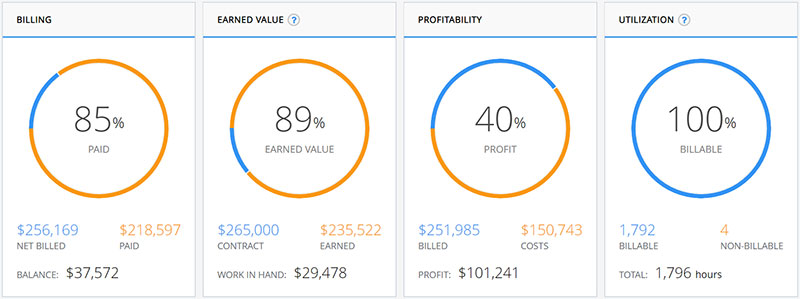Big data. Business intelligence. Analytics. Artificial Intelligence.
These terms may seem like sophisticated business strategies reserved for only the largest, Fortune 500-type companies.
You may be surprised to learn, however, that small organizations with up to 100 employees had the highest rate of business intelligence penetration or adoption in 2018.
In this blog, we'll explore the top reasons that organizations of all sizes are using business intelligence and analytics to improve operational efficiencies.
Business Intelligence and Analytics: A Quick Overview
Business intelligence is to analytics like flour and eggs are to cake. Intelligence is the raw data used to form insights (i.e., the analysis of that data). That intelligence is usually gathered through a combination of software and other tools and translated into reports that inform business operations.
At its foundation, business intelligence helps organizations better understand the factors that shape their results and then take action based upon that knowledge.
For example, an engineering firm that tracks time and expenses across hundreds of engineers may find that certain types of projects almost always take the same amount of hours. They can use this data, in conjunction with a specific engineer's hourly rate, to automatically generate cost estimates for clients before beginning a project.
This allows the firm to more accurately budget for accounts receivables. It also gives the client peace of mind that they won't be surprised with a larger-than-expected invoice when the work is complete.
While there are vendors that market their products exclusively as business intelligence (BI) solutions, many types of software applications—including our own CORE business management software—deliver business intelligence and analytics. CORE offers these tools in the same application as its project management and accounting software for seamless data flow.
BI solutions typically have some of the following characteristics:
-
They draw data from multiple sources (e.g., CRM, project management tools, employees)
-
They integrate with other tools (e.g., Quickbooks, data warehouses)
-
They retrieve, analyze and/or transform data
-
They display compiled data in the forms of dashboards or reports
-
Ideally, they suggest actionable improvements (e.g., you can reduce inventory by 2% and still meet objectives)
-
The main value of BI and analytics is taking complex data and translating it into actionable plans
Top Reasons for Using Business Intelligence
The Business Application Research Center surveyed hundreds of business intelligence users from across the globe and found the top four reasons for using business intelligence were for:
-
Faster reporting, analysis of planning (91%)
-
More accurate reporting, analysis or planning (88%)
-
Better business decisions (84%)
-
Improved data quality (78%)
There are, of course, many reasons organizations turn to business intelligence and analytics to improve their operations. These are the most frequently cited motivations.
Reliance on Multiple Data Sources for Decision-Making
Historically, companies used time-consuming processes or isolated data to define whether they were making progress toward their goals. They might rely on monthly sales reports, for example, to forecast future revenue.
While sales figures alone have value, they don’t provide the full picture of organizational health if they're not combined with other data. For instance, they don't take into account the cost of acquisition or post-sale onboarding costs.
Revenue might be trending well, but net profit could still be on the decline. BI combines data from multiple sources to provide a more comprehensive view of operations. This makes it easier to identify areas for improvement.
Improved Operational Efficiencies & Competitiveness
Growth stagnates when businesses delay decisions due to insufficient data or their inability to easily analyze data. As a result, capital investments, strategic shifts, and product development may suffer.
Business analytics are key to guiding decisions that can quickly improve operational efficiencies, reduce costs and keep organizations competitive.
Faster Insights Through Visualization
They say a picture is worth a thousand words. While there are some auditory and kinesthetic learners among us, a full 65% of the population are visual learners.
That's one of the chief benefits of most BI solutions. They provide highly visual outputs (e.g., charts, graphs, dashboards) that tell a story far better than any spreadsheets could.
For example, you can see an engineer's utilization rate, realization rate, and gauge their average performance across all projects or look at specific project types — all from in screen with easy-to-understand charts and graphs. You now have actionable data you can use to inform resource allocation such as staffing and scheduling for different projects.

Contrast that with the time-sucking alternative of sifting through pages of reports, manually analyzing the disparate data, and converting the findings into a PowerPoint presentation for the team. Visual data helps organizations discover insights faster, keeping them more agile.
Uncover Important Insights into Customer Behaviors
Retargeting in digital advertising is a great example of how business and artificial intelligence can be leveraged to increase revenue. You visit Amazon and click on a pair of stylish pants and before you know it, you're seeing an ad for those same pants pop up in your email account 10 minutes later.
Likewise, Business Intelligence gives you insights in your clients' behavior so you can see the ROI for specific projects and clients.
Is the cost of doing business with a client worth the revenue they generate or the profit they bring? Do clients who need Service A tend to also need Service B down the road? Why is the profit margin for projects with Client X higher than Client Y? How can you change your budgeting, forecasting, and staffing to address these trends? A good BI system can help you answer these questions and make the right decisions.
Business Intelligence: It's for Everyone in Professional Services
Engineering firms, architectural firms, law groups, accounting practices, and other professional services firms are using business intelligence and analytics to effectively manage people, projects, and profitability.
If you'd like to see how business intelligence and analytics can make a different in your firm, click below to try CORE for free.
